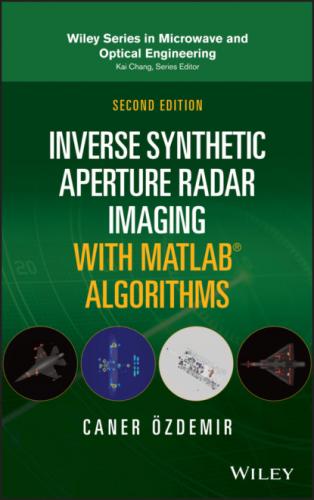In Chapters 4, 5, 7, and 12 where we handle various aspects of ISAR imaging technology, new scattered field raw data and the corresponding ISAR images that are more visually attractive are presented together with the associated Matlab codes that can be used to generate these images.
A total of three new chapters have been written to cover the topics that were not considered in the first edition and also to include more detailed subjects of ISAR imaging to be able to reflect the recent research studies. These are listed below:The “Bistatic ISAR (Bi‐ISAR) Imaging” concept is covered in Chapter 9. While the ISAR imaging algorithms presented in previous chapters are based on monostatic usage of ISAR imaging, we introduce the formulation of ISAR imaging for the bistatic usages by presenting key aspects such as resolutions in range/cross‐range directions and usage limitations. Also, extension of Bi‐ISAR to multistatic ISAR (Mu‐ISAR) imaging is derived with the associated Matlab examples. A general assessment of Bi‐ISAR and Mu‐ISAR imaging to conventional monostatic ISAR imaging is being made throughout the chapter by comparing the outcomes of quantitative metrics and giving the concluding statements about their advantages and disadvantages based on these measurable evaluations.In Chapter 10, we have added a new and exciting research topic of ISAR called “Polarimetric ISAR Imaging.” As the traditional ISAR imaging algorithms are based only on a single polarization of the backscattered electric field, we demonstrate in this chapter that very exciting features of the target can be extracted with the use of other possible polarizations for the reflected wave. Polarization decomposition techniques are being introduced and Pauli decomposition scheme is taken as the tool to be applied to the different polarization ISAR images in this book. The formulation and the usage of Pauli decomposition technique are presented together with its Matlab codes. Various realistic simulation examples based on linear polarization, circular polarization, and also Pauli decomposition are given together with obtained polarimetric ISAR images. It has been demonstrated through the examples that polarized ISAR images definitely increase the recognition and classification of targets by providing increased number of extracted target features.Thanks to the recent development in the microwave circuit technology and antenna design, ISAR imaging algorithms have been started to be used in the near‐field region. Therefore, I have added a new part entitled “Near‐field ISAR imaging” as Chapter 11. The near‐field ISAR imaging algorithms are being introduced. Two of them called “Focusing operator” and the back‐projection based focusing algorithms are given by presenting their theoretical formulation and algorithm steps together with corresponding Matlab codes. Also, numerical and measured examples based on real scenarios are being shared.
In Chapter 12 in which some examples based on SAR/ISAR imaging technologies are provided, I have previously introduced algorithms called antenna SAR (ASAR) and antenna coupling SAR (ACSAR) as the unique radar imaging algorithms to image antenna mounted on a platform‐to‐radar receiver interaction over the target and to image platform coupling over the antennas mounted on a target, respectively. In this edition of the book, I have added some new applications such as ground‐penetrating radar (GPR) and through‐the‐wall imaging radar (TWIR) that also make use of SAR/ISAR imaging algorithms. Measured examples of GPR and TWIR radar images are provided to demonstrate how SAR/ISAR imaging algorithms can be effectively used in some popular radar imaging applications.
I hope that, with the new edition of the book “Inverse Synthetic Aperture Radar Imaging with MATLAB Algorithms,” the reader would benefit more in terms of abovementioned new ISAR imaging topics and also from the Matlab codes provided at the end of chapters.
All MATLAB files may be accessed on the following FTP site: ftp://ftp.wiley.com/public/sci_tech_med/inverse_synthetic.
Caner Özdemir Mersin, October 2020
Acknowledgments
I would like to address special thanks to the people below for their help and support during the preparation of this book. First, I am thankful to my wife, Betül and my three children for their patience and continuous support while writing this book. I am very grateful to Dr. Hao Ling, Emeritus Professor in Engineering of the University of Texas at Austin for being a valuable source of knowledge, ideas, and also inspiration throughout my academic carreer. He has been a great advisor since I met him, and his guidance on scientific research is priceless to me.
I would like to express my sincere thanks to my former graduate students; Dr. Şevket Demirci, Dr. Enes Yiğit, Dr. Betül Yılmaz, Dr. Deniz Üstün, Özkan Kırık, and Dr. Hakan Işıker who have helped carrying out some of the research presented in this book. I would also like to thank my graduate student Rasheed Khankan for his help in preparing references.
Last but not least, I would like to convey my special thanks to Dr. Kai Chang for inviting me to write the first and then second edition of the book. Without his kind offer, this book project would not have been possible.
Caner Özdemir
Acronyms
1DOne‐dimensional2DTwo‐dimensional3DThree‐dimensionalACSARAntenna coupling synthetic aperture radarADCAnalog‐to‐digital converterANNArtificial neural networkASARAntenna synthetic aperture radarATCAutomatic target classificationATRAutomatic target recognitionBi‐ISARBistatic inverse synthetic aperture radarBPABack‐projection algorithmCADComputer aided designCDFCumulative density functionCFARConstant false alarm rateCOContrast optimizationCo‐polCo‐polarizationCPCircular polarizationCross‐polCross‐polarizationCSAChirp scaling algorithmCWContinuous waveDCRDihedral corner reflectorsDFTDiscrete Fourier transformDTVDigital televisionEFIEElectric field integral equationEMElectromagneticESMExploding source modelFMFrequency modulatedFMCWFrequency modulated continuous waveFTFourier transformGOGeometric opticsGPRGround‐penetrating radarGPSGlobal positioning systemGWNGaussian white noiseHHorizontalHHHorizontal–horizontalHSAHyperbolic summation algorithmHVHorizontal–verticalIInphaseIDFTInverse discrete Fourier transformIFTInverse Fourier transformIMUInertial measurement unitInSARInterferometric SARISARInverse synthetic aperture radarJTFJoint time‐frequencyKBKbytesKMAKirchhoff migration algorithmLLeftLFMLinear frequency modulatedLFMCWLinear frequency modulated continuous waveLHCPLeft‐hand circular polarizedLHEPLeft‐hand elliptically polarizedLLLeft–leftLOSLine of sightLPLinear polarizationLRLeft–rightMBMbytesMDAMap‐drift autofocusMFIEMagnetic field integral equationMIMOMultiple‐input multiple‐outputMOCOMPMotion compensationMu‐ISARMulti‐static inverse synthetic aperture radarPECPerfect electric conductorPGAPhase gradient autofocusP‐ISARPassive inverse synthetic aperture radarPOPhysical opticsPolSARPolarimetric synthetic aperture radarPPPProminent point processingPRFPulse repetition frequencyPRIPulse repetition intervalPSDPower spectral densityPSFPoint spread functionPSLRPeak‐to‐sidelobe ratioPSMAPhase‐shift migration algorithmPSRPoint‐spread‐responseQQuadratureQDQuadradure detectionRRightRCMRange cell migrationRCMCRange cell migration correctionRCSRadar cross sectionRDARange‐doppler
